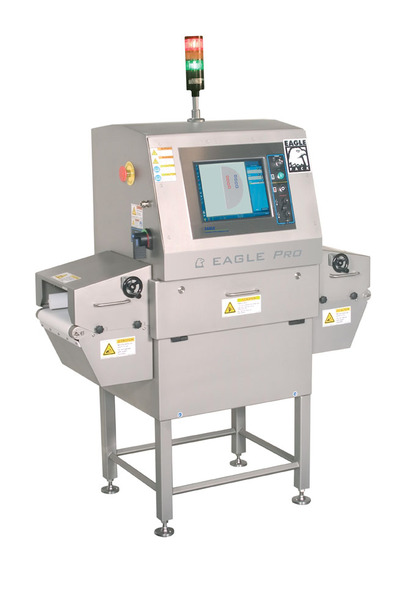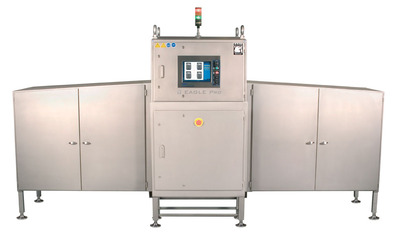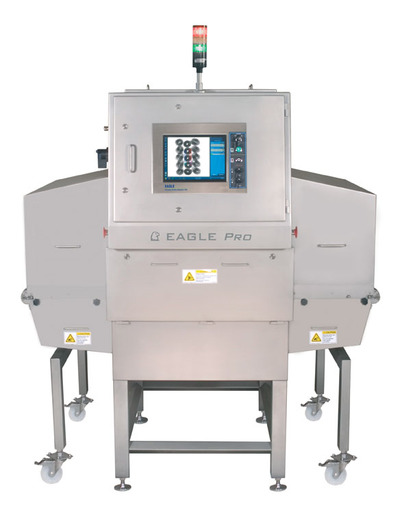The evolution of X-ray inspection systems
By Terry Woolford, General Manager, Eagle Product Inspection (Formerly Smiths Detection PID)
Wednesday, 26 October, 2011
A look at how X-ray product inspection in the food industry has advanced in recent years to meet ever-increasing consumer demands.
Over the last few years, X-ray systems for food manufacturers have matured. Gone is the day when food was painstakingly inspected by hand, which was a time-consuming process; today, technologically advanced machines identify a multitude of contaminants in a variety of foods, products and packages. With ever-changing trends in the food industry, X-ray inspection equipment has evolved to meet the new demands that increasingly innovative packaging designs are impacting on the inspection process.

Detecting contaminants in multitextured foods
A growing consumer trend affecting manufacturers is the desire for multitextured foods, such as bags of mixed salad leaves. These types of packaged goods have many density levels resulting in a crowded X-ray image, posing new challenges for identifying contaminants. As such, extra demands are being made on image analysis software to find contaminants. Material Discrimination X-ray (MDX) technology, which is especially useful with variable density ‘busy’ images, is a good solution to this new-found problem. Originally pioneered for use in the security sector, MDX technology is able to discriminate materials by their chemical composition and allows the detection and rejection of historically undetectable inorganic contaminants such as glass shards, rocks, rubber and plastic. New product inspection systems now come equipped with MDX dual-energy algorithms that increase contaminant detection of foreign bodies previously unseen by X-ray or any other conventional means in difficult product applications.
Problems caused by innovative packaging designs
New and innovative packaging designs, such as fold-out cardboard sandwich packaging and corrugated card encasements, have also led to their own challenges. Machines previously calibrated to scan standard types of packaging have had to adapt to be able to accurately analyse new shapes, sizes and materials such as flexible packaging and pouches. Recent advancements in technology now enable X-ray inspection equipment to simultaneously perform a wide range of inline quality checks such as verifying fill level, measuring headspace and verifying component presence and absence to alert manufacturers to over- or under-fulfillment to avoid waste. The blind spots that had previously occurred at the bottom of upright containers such as glass jars, bottles and composite lines are also easier to inspect today with machines that use enhanced contaminant detection technologies, such as MDX.

Contaminant detection in foil pouches and tin cans
Goods in tin cans or foil pouches have also posed a problem for manufacturers when inspecting for metal contaminants within the container. Detection of metal and foreign contaminants in food packaged within foil and metal is impossible with a conventional metal detector and so the development of X-ray metal detection technologies has made this achievable.
Food and drug safety regulations, along with the requirements of large food retailers, have also been a driving force in the industry to improve X-ray inspection machinery. Although there are no legal requirements to use X-ray inspection, guidelines such as Hazard Analysis Critical Control Point (HACCP) have put the onus on manufacturers to establish reliable and fully documented product inspection programs. The HACCP management system addresses the inspection of food by analysing and controlling biological, chemical and physical hazards. It is used by manufacturers at all stages of food production and preparation processes including inspection, packaging and distribution.
As packaging continues to evolve to appear attractive to consumers, X-ray inspection machines will continue to progress in order to meet these ever-changing demands. Equally, as retailers demands increase and food and drug safety regulations intensify, compliance and traceability through every stage of a product’s life cycle will grow in importance. Eventually all product inspection equipment will need to be tailored to dually function as a management tool and food safety measure.

The Eagle Product Inspection (Formerly Smiths Detection PID) line of X-ray inspection systems evaluates in process and finished products for contaminants such as metal, glass, stone and bone while also having the ability to check mass, evaluate compartmentalised fill level,and analyse fat content. With its headquarters in Tampa, Florida, and local offices across the globe, Eagle Product Inspection machines meet today’s HACCP certification requirements to ensure that food and beverage manufacturers and their customers in turn are well protected.
Eagle Product Inspection was acquired by Mettler-Toledo in March 2011. The business adopted the Eagle brand which has been used for its products since 1998. The Eagle business joins the Mettler-Toledo Product Inspection family of brands: Garvens, Hi-Speed, Safeline and CI-Vision.
Eagle Product Inspection equipment is distributed in Australia and New Zealand by Food Processing Equipment.
Cool melt: is it worth switching?
Why use high-temperature melt adhesives when low-temperature adhesives are also an option? This...
Visy trials its new recyclable fibre-based thermal insulation
Visy is trialling its new insulation alternative to polystyrene, Visycell, which has been...
Re-In-Can-Ation project making Stone & Wood cans more sustainable
Visy is working with Stone & Wood on a pilot project called Re-In-Can-Ation to make beer cans...














